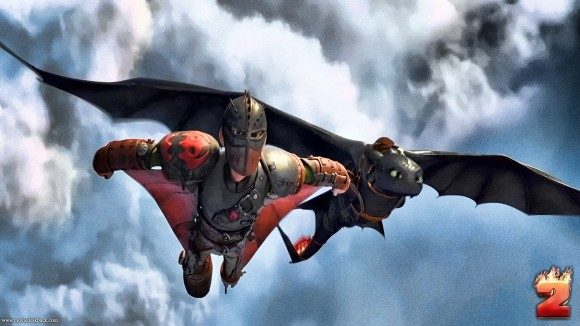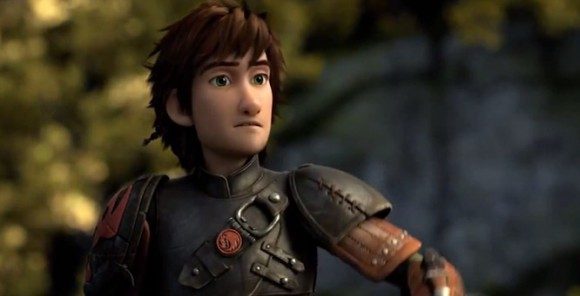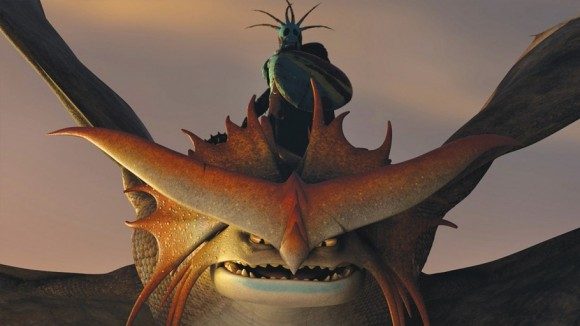I think most people probably expected the original How To Train Your Dragon to be a hit in the same way most people expected the original Star Wars to be. As in they didn’t, really. And prone though I am to making Star Wars references and comparisons, I’m going to start there because that’s also where How To Train Your Dragon 2 director Dean DeBlois started. In a short Q&A following my screening, DeBlois talked about the difficulty of approaching a sequel to any film, and how The Empire Strikes Back became an example for the production as a high water mark, an example worth emulating for the way it didn’t rehash the original, but expanded upon it. That influence is readily apparent: How To Train Your Dragon 2 is an expansive, enormously entertaining movie that deftly avoids sequel fatigue.
One of the bravest decisions, certainly, was the choice to set the film five years after the first movie. It’s also a decision that pays some of the greatest dividends. How To Train Your Dragon 2 manages to strike the delicate balance between acknowledging the fans of the first movie and being accessible to newcomers. The events of How To Train Your Dragon created a new status quo for the Vikings of Burke (the bluffside town where our heroes live), meaning that Dragon 2 is introducing all audiences to a world that’s been fundamentally changed, even if there are parts of it that will seem familiar to some. So a newcomer will look on Hiccup’s (our Viking protagonist, voiced by Jay Baruchel) flair for invention or his budding romance with Astrid (America Ferrera) and see well-rounded, interesting characters, while the series fan will know that those things are the result of subplots from the first movie. The new paradigm grows so organically out of the old that the history underwriting it is almost a tangible thing. The movie is free to drop all viewers into its world and expect they’ll be able to catch on without much exposition because it knows that the backstory is being suggested with every frame.
This also frees the narrative to keep its eyes focused on the horizon. The movie kicks off with a couple visually brilliant sequences where we are reintroduced to the main characters and supporting cast and get to see just how far they’ve come in five years. Hiccup, for example, has grown in stature both socially and physically. He’s no longer an awkward teen, but a confident adult just beginning to come into his own. As the movie opens, he’s pushing the boundaries of the world he knows, literally adding to the edges of the map. For almost the first half hour of the film I couldn’t help but grin for the joy of watching.
The pinnacle of all this comes maybe a third of the way into the movie, just after it’s begun to make the turn into the main plotline. While mapping a new area, Hiccup and Toothless (his dragon) encounter a mysterious unknown dragon rider and end up caught a series of caves with the rider, who may or may not mean harm for them, and a host of dragons under the rider’s control. The sequence of their interaction is a tour-de-force of weighty mystery bathed in potential menace that conveys more meaning nonverbally than most scenes can packed full of words. My only regret is that it resolved itself too quickly.
On the technical side of things, Dragon 2 somehow looks markedly better than the original, easily rivaling what’s being put out by anyone else working in computer generated animation. The detail work is so good (especially noticeable in characters’ hair) that it’s actually to the point where the skin is the weak link, if there is one, looking just a bit too flat and sheeny for its own good. A major factor in this may be the fact that acclaimed cinematographer Roger Deakins was brought on to consult for the film. In the post-screening Q&A, DeBois talked about how he and Deakins brought together the shot composition and lighting teams, two steps in the animation process which have traditionally been separate. The result is a more lifelike animated image. I didn’t immediately equate the improved image with improved lighting while watching the film, but I did take notice of how great everything looked right away.
Here’s the other surprising thing about the visuals: I saw the movie in 3D. If given the choice, I’ll usually see a movie in 2D rather than 3D (Gravity was a notable exception), but I happened to go to a 3D screening for this and I am very glad I did. The movie never pulled on of the “coming at your face” gags that are a constant annoyance in so many 3D films, instead using the effect to create stunning depth-of-field. I still experienced some of the motion blur typically associated with 3D films, but it was a minor issue compared to how pretty may of the (especially slower moving or stagnant) shots looked.
How To Train Your Dragon 2 isn’t without a few missteps, however. As I mentioned before, the strongest parts of the film come near the beginning, with my favorite sequence of the movie appearing shy of halfway through the runtime. That doesn’t mean the rest of the film is a drag – the crisis moment of the plot is an incredibly powerful one– but there is an inescapable sense that the movie is just trying to hang on until the ending without losing too much altitude. The plot device that’s used both to induce that crisis moment and solve the climax feels very forced. It makes the narrative work without tripping over itself, but it doesn’t have the same organic-to-this-world quality of so much of the rest of the movie.
The film has to rely on that device, though, because it finds itself weak at the villain position. Time spent developing some of the characters and plotlines through the middle of the film are well spent (and it’s very possible more could have been done there as well), but this robs time from really fleshing out the villain or his plan, and the parts of the movie where he’s a major player feel rushed and incomplete as a result.
The Verdict: 4 out of 5
How To Train Your Dragon 2 does a lot of things very, very well, especially in the way it makes itself compelling both as a standalone film and as the second part of a trilogy. I’d place it just a notch over its predecessor, maybe two or three when you consider how gorgeous this movie looks (not that the original was any slouch, but that’s exactly the point). Dragon 2 does have trouble sustaining the incredible highs it hits early through the end of the film, but it the second half proves good enough that we’re allowed to focus on those moments of brilliance rather than deficiencies elsewhere.




